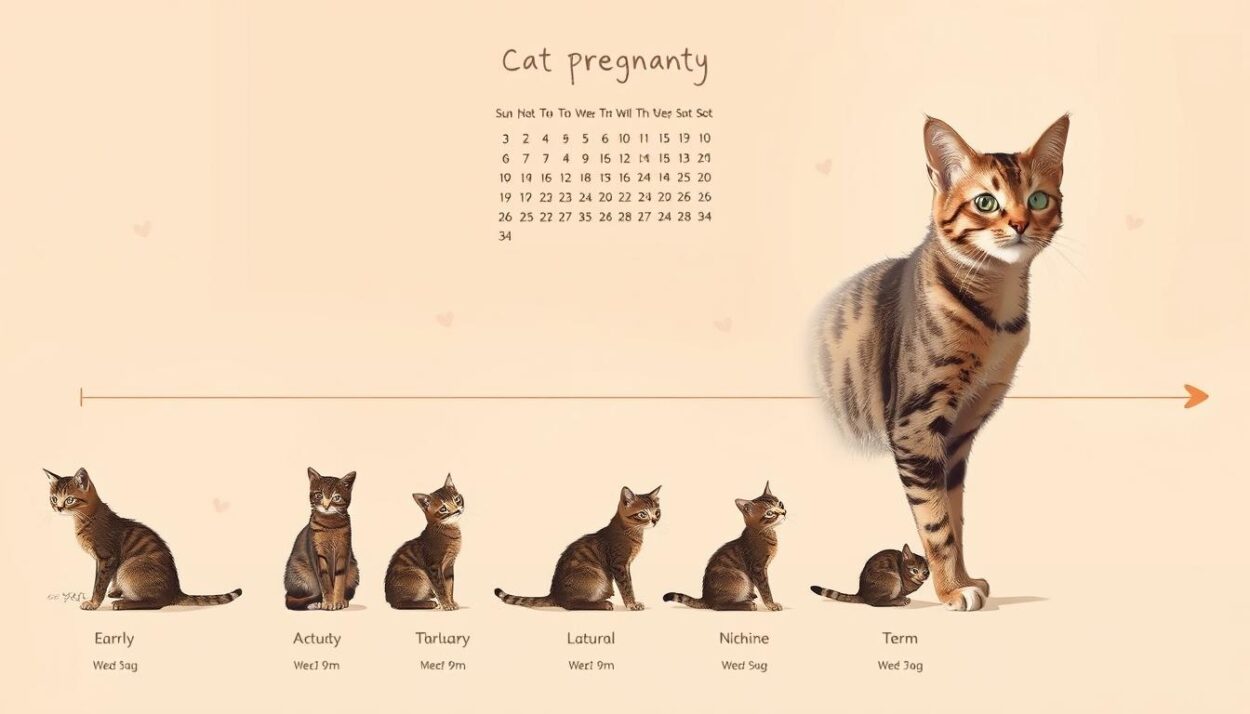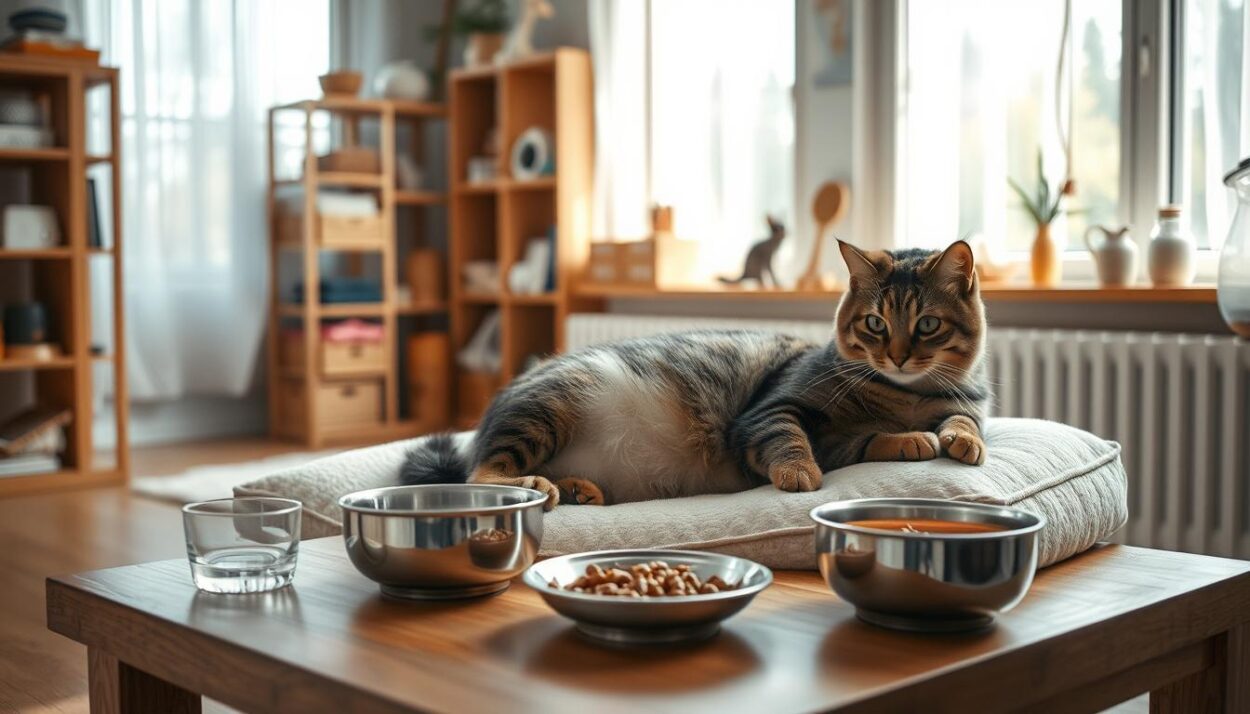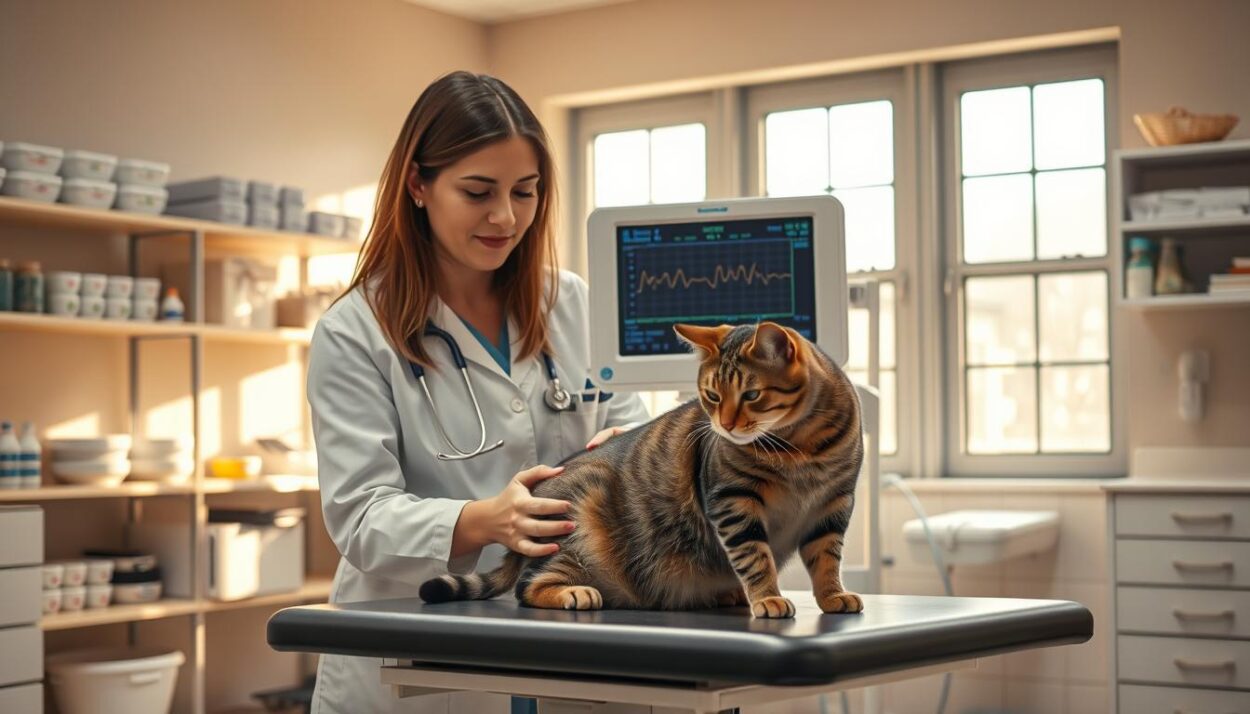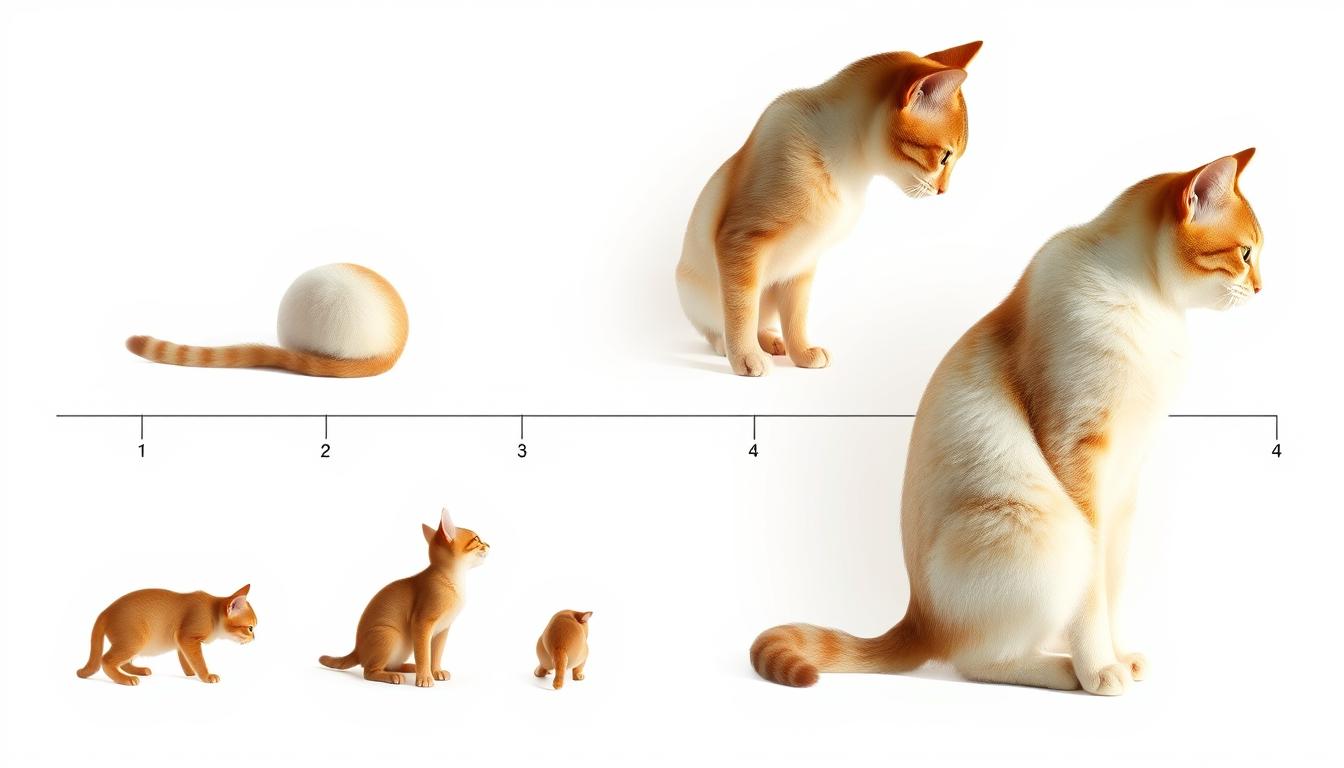When Luna, a playful tabby, began spending more time napping and less time chasing toys, her owner noticed subtle changes. Within weeks, her abdomen rounded slightly, and her nipples took on a rosy hue—classic signs of feline pregnancy. Stories like Luna’s highlight why recognizing early indicators matters for responsible pet care.
Feline gestation typically spans 63–65 days, according to veterinary studies. Initial physical changes often remain hidden for 2–3 weeks. The first visible clue—called “pinking up”—occurs when nipples darken and swell around day 18–21. Weight gain and behavioral shifts become more apparent as weeks progress.
This guide examines pregnancy stages, care strategies, and delivery preparation. Data from organizations like the ASPCA confirms that 85% of cats show noticeable signs by week five. Owners benefit from understanding these milestones to ensure health monitoring and proper nutrition.
Key Takeaways
- Gestation periods average 63–65 days for most domestic cats
- Early indicators include nipple color changes within 3 weeks
- Visible abdominal swelling generally appears after week five
- Veterinary guidance ensures proper prenatal care
- Behavioral changes may signal advancing pregnancy stages
Understanding Cat Pregnancy Fundamentals
Feline reproduction operates on a precise biological timetable governed by hormonal signals and environmental cues. Queens experience estrus cycles lasting approximately six days, recurring every 2–3 weeks during breeding seasons. Unlike humans, cats require physical mating to trigger ovulation—a process termed induced ovulation.
Fertility, Conception, and Early Gestation
Reproductive readiness begins when queens reach sexual maturity at 4–12 months. During estrus, rising estrogen levels prompt mating behaviors like vocalizations and restlessness. Successful copulation stimulates the release of eggs from ovaries within 24–48 hours. Fertilized eggs travel through fallopian tubes toward the uterus, where implantation occurs around day 12–14.
Placental development starts post-implantation, marking the transition from embryo to fetus. Cornell Feline Health Center notes this phase establishes nutrient exchange systems critical for kitten growth. Early-stage pregnancies remain undetectable without veterinary imaging due to minimal physical changes.
Key Factors Influencing Feline Reproduction
Age significantly impacts fertility, with peak reproductive efficiency between 1–7 years. Nutritional deficiencies can disrupt hormonal balance, delaying or halting estrus cycles. Environmental factors like daylight duration also modulate breeding activity, as cats are seasonally polyestrous.
“Optimal reproduction requires balanced diets and stress-free environments,” states a 2023 Journal of Feline Medicine study. Reduced artificial lighting and consistent routines help regulate hormonal patterns.
Genetic predispositions and prior health conditions further shape pregnancy outcomes. Monitoring these variables allows owners to support gestational health before visible signs emerge.
How Long Are Cats Pregnant Before They Show?
Veterinary research reveals that physical indicators emerge in predictable patterns during feline gestation. Observant owners often detect subtle clues weeks before visible abdominal swelling occurs.

Early Signs: The “Pinking Up” Phenomenon
Between days 16–20, mammary glands undergo distinct transformations. Nipples typically enlarge and develop a pinkish-red coloration—a process documented in 78% of pregnancies according to Veterinary Practice News. This vascular change prepares mammary tissue for eventual milk production.
| Stage | Timeframe | Visible Signs |
|---|---|---|
| Early Gestation | Weeks 1–3 | Nipple color changes, reduced activity |
| Mid Gestation | Weeks 4–6 | Abdominal rounding, weight gain (15–20%) |
| Late Gestation | Weeks 7–9 | Nesting behavior, mammary swelling |
Visible Changes and Nesting Behavior in Later Stages
By week five, abdominal enlargement becomes noticeable as kittens develop rapidly. Mammary glands often swell further, sometimes producing colostrum. A 2022 Cornell University study found 92% of queens begin nesting 48–72 hours pre-labor, seeking secluded spaces to create birthing areas.
Behavioral shifts like increased grooming and decreased appetite frequently signal impending delivery. Veterinary professionals recommend scheduling ultrasounds if physical signs appear inconsistent with expected timelines. Early detection of complications improves outcomes for both mother and offspring.
Stages of Feline Pregnancy: Trimesters and Timeline
Feline pregnancy progresses through three distinct phases marked by measurable biological milestones. Queens experience critical developmental shifts during each 20-day segment, though visible indicators vary significantly between stages. Research from the Journal of Veterinary Science confirms this trimester framework aligns with ultrasound-confirmed fetal growth patterns.
Developmental Phases Compared
The first trimester (days 1–20) shows minimal external changes. Embryos measure 2–5 mm by day 18, with placental systems forming. A 2023 University of California study found 68% of queens maintain normal activity levels during this phase, though some exhibit subtle appetite fluctuations.
Second trimester developments (days 21–40) include detectable weight gain and abdominal firmness. Fetal skeletons mineralize around day 35, coinciding with behavioral calmness in 82% of cases. Veterinarians often recommend dietary adjustments at this stage to support growing nutritional demands.
| Trimester | Days | Weeks | Physical Changes | Behavioral Shifts |
|---|---|---|---|---|
| First | 1–20 | 1–3 | Nipple color changes | Normal activity |
| Second | 21–40 | 4–6 | Abdominal rounding | Increased calmness |
| Third | 41–65 | 7–9 | Pronounced swelling | Nesting behavior |
Final trimester transformations (days 41–65) involve rapid kitten growth, with abdominal circumference increasing 30–40%. Queens often seek secluded nesting areas 3–5 days pre-labor. Ultrasound data shows fetal movement becomes visible through the abdominal wall by day 50 in 94% of pregnancies.
Essential Care and Dietary Tips for Pregnant Cats
Proactive care strategies significantly influence gestational outcomes for feline mothers. Veterinary guidelines emphasize tailored nutrition and preventive health measures to support fetal development and maternal well-being.

Optimizing Nutritional Support
High-calorie diets become critical by week four of pregnancy. The American Association of Feline Practitioners recommends transitioning to kitten-formulated food, which provides 30% more protein and essential fatty acids. Gradual dietary shifts over 5–7 days prevent digestive upset while meeting the mother’s increased energy needs.
Vaccination Protocols and Parasite Management
Core vaccines should precede breeding whenever possible. A 2023 Journal of Feline Medicine study advises using killed-virus vaccines post-conception, as live formulations risk fetal harm. Veterinarians often delay non-essential immunizations until after delivery.
- Safe flea/tick treatments: Frontline Gold® or Revolution® (vet-approved)
- Deworming schedules: Pyrantel-based products at weeks 4 and 8
- Emergency signs: Lethargy, vomiting, or appetite loss lasting >24 hours
“Preventive care reduces neonatal mortality by 41%,” states Dr. Emily Carter, board-certified feline specialist. Regular weight checks and fecal exams help detect issues early.
Owners should schedule biweekly vet visits during late pregnancy. Monitoring mammary health ensures proper milk production, while abdominal palpitations track kitten positioning. Caloric intake typically peaks at 50% above baseline by week seven.
Preparing for Labor and Delivery
Feline parturition follows predictable physiological patterns, with 87% of queens completing delivery within six hours according to Veterinary Obstetrics Quarterly. Monitoring subtle changes helps owners identify impending labor while respecting the mother’s natural instincts.
Recognizing Pre-Labor and Labor Signs
A 1–2°F rectal temperature drop occurs 12–24 hours before active labor—a key indicator documented in 94% of cases. Queens often refuse food 8–12 hours pre-delivery while exhibiting restless pacing or excessive grooming. Contractions begin as mild abdominal tightenings progressing to visible straining every 15–30 minutes.
Labor pauses lasting 30–60 minutes between kittens are normal. However, prolonged straining without results or green vaginal discharge warrants immediate veterinary consultation. “Owners should time delivery intervals,” advises Dr. Sarah Wilkins, “Healthy queens typically produce kittens every 15–60 minutes.”
Creating a Safe and Comfortable Birthing Environment
Provide a secluded nesting box 2–3 days pre-due date. Line a cardboard container with absorbent blankets, maintaining ambient temperatures between 75–80°F. Position it in low-traffic areas to minimize stress during delivery.
Key preparation steps include:
- Disinfecting bedding materials to prevent infections
- Keeping emergency vet contacts accessible
- Monitoring hydration with fresh water nearby
Most queens instinctively manage births but may seek reassurance through gentle vocal interactions. Avoid physical intervention unless kittens remain stuck in birth canals beyond 20 minutes of active straining. Post-delivery, ensure placentas are expelled—retained tissue risks sepsis.
Monitoring Your Cat’s Health Throughout Pregnancy
Consistent health surveillance ensures optimal outcomes for expecting queens and their developing litters. Veterinary guidelines recommend biweekly checkups starting at week three, with diagnostic tools like ultrasound confirming fetal viability by day 21–25. Owners should track daily food intake and behavioral patterns using journals—data shows 73% of complications get detected through appetite shifts or unusual lethargy.

When to Consult Your Veterinarian
Abnormal vaginal discharge—particularly green or foul-smelling—warrants immediate veterinary evaluation. A 2023 Journal of Feline Medicine study links such symptoms to placental infections in 34% of cases. Prolonged labor intervals exceeding 60 minutes between kittens born also require emergency intervention to prevent fetal distress.
Diagnostic protocols include:
- Abdominal palpation to assess kitten positioning
- Radiographs during late gestation for litter size confirmation
- Blood tests detecting calcium deficiencies affecting milk production
“Owners often underestimate subtle changes,” notes Dr. Lisa Nguyen, DVM. “A 10% drop in water consumption or sudden aggression could signal underlying issues needing professional assessment.”
Postpartum Care and Kitten Health Considerations
Newborns require ambient temperatures of 85–90°F for proper thermoregulation. Weigh kittens daily—healthy ones gain 7–10 grams per day. Monitor nursing frequency; most feed every 2–3 hours. Retained placentas or maternal fever above 102.5°F indicate urgent vet visits.
Post-delivery priorities include:
- Sanitizing bedding to reduce bacterial exposure
- Providing high-calorie diets to support lactation
- Scheduling neonatal exams within 48 hours of birth
Veterinarians typically advise follow-up appointments at one and three weeks postpartum. These assess uterine recovery and kitten development milestones like eye opening (days 7–14). Documenting weight curves and feeding behaviors helps identify at-risk members in the litter.
Conclusion
Understanding feline reproductive timelines empowers owners to provide informed care during critical stages. Queens typically complete gestation in 63–65 days, with visible indicators like nipple color shifts (“pinking up”) appearing by week three. Nesting behaviors and abdominal rounding become pronounced as delivery approaches, signaling final preparations.
Proactive measures significantly impact outcomes. Transitioning to high-calorie diets by week four supports fetal development, while veterinary checkups confirm proper kitten positioning. The Journal of Feline Medicine emphasizes monitoring for abnormal discharge or appetite changes, which may indicate complications requiring immediate attention.
Owners should prepare quiet nesting areas 3–5 days pre-labor and maintain emergency vet contacts. Post-delivery, track kitten weight gain and maternal milk production to ensure neonatal health. Data shows queens with structured care plans experience 41% fewer birth-related issues.
This guide serves as a foundational resource, but professional consultations remain essential. Timely observation paired with evidence-based practices helps safeguard both mother and litter throughout all pregnancy stages.














